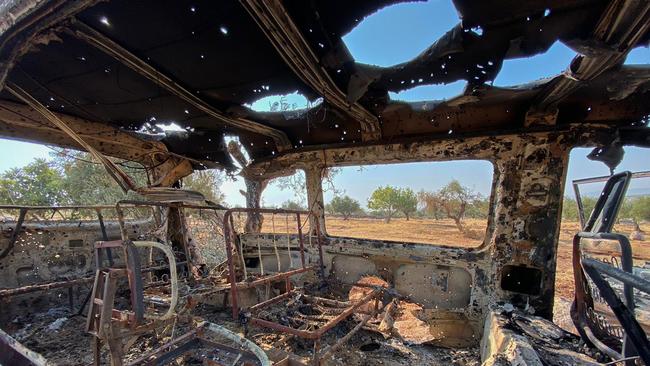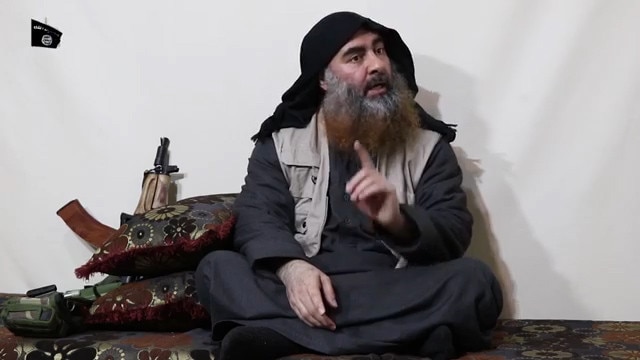Iraq led CIA to Baghdadi
Iraq intelligence provided the CIA with the co-ordinates of Abu Bakr al-Baghdadi’s location before he was reportedly killed.

Iraq’s intelligence service provided the US-led coalition with the co-ordinates of Islamic State leader Abu Bakr al-Baghdadi’s location, paving the way for the raid that reportedly killed him, an Iraqi intelligence official says.
The agency learned of Baghdadi’s location from documents found at a secret location in Iraq’s western desert after arresting an Iraqi man and woman from within his “inner circle”, the official said.
“We have been constantly co-ordinating with the CIA, providing valuable information that the Iraqi National Intelligence Service has on Baghdadi’s movements and place of hiding,” the official said.
Earlier, the commander-in-chief of the US-backed Syrian Democratic Forces who have been fighting ISIS in Syria said the operation came after “joint intelligence work” with American forces.
In Baghdadi’s only publicised propaganda video this year, he had specifically encouraged Australian jihadists to wage a wave of terror.
For years, the 48-year-old Islamic State leader was able to galvanise and inspire sleeper cells and individual supporters to launch chilling terror attacks inside Western countries with little more than religious extortions about the caliphate and non-believers.
He promoted the most extreme form of Islam, and under his leadership Islamic State carried out beheadings and caged burnings of Western captives in Syria.
From a secret bunker in the Syrian desert, the shadowy leader was believed accountable for nearly 100 terrorist attacks outside Syria and Iraq in 20 countries, such as the Bataclan atrocity in Paris, the truck attacks in Nice and the Berlin Christmas market, as well as Australia’s Lindt cafe siege, the knife attack on two police officers at Endeavour Hills in 2014 and even the foiled 2015 Anzac Day terrorist plot in Melbourne.
Baghdadi’s last video was released in April, referencing some recent attacks to date stamp it and prove that he was still alive despite rumours of his death in airstrikes several years earlier.

He had not been seen for five years before the video was released. In it, Baghdadi praised Islamic State fighters from France, Australia, Belgium and Chechnya, highlighting how his organisation had infiltrated the world and demanding continued allegiance. He indicated Islamic State would encourage liaisons with other terrorist organisations to spread its jihadist message.
By this time, his so-called caliphate had been reduced to a tiny section of Syria along the Euphrates River, a far cry from Islamic State’s high point of 2015 and 2016 when it controlled millions of people from northern Syria almost down to the Iraqi capital Baghdad.
Last month, Islamic State media outlet published a 20-minute audio message from Baghdadi urging his supporters to free the terrorist group’s “sisters’’ being held in Syrian and Iraqi camps. There were fears from Western intelligence agencies that amid the political turmoil of the region, sparked when President Donald Trump withdrew US troops and allowed a Turkish incursion into northeastern Syria, would spark a revival of Islamic State, especially if the Kurdish-guarded prisoners were released.
Iraqi sources say Baghdadi was located in the desert outside Barisha, Idlib province, in the northwest of Syria and closer to the Turkish border — a stronghold of rebel groups hostile to Islamic State — trying to get his family closer to the Turkish border to escape.
Early reports indicate Baghdadi, who had led Islamic State since 2010, detonated a suicide vest as US forces closed in, killing himself and his bodyguard. Witnesses described an aerial helicopter attack outside the town, with early reports saying about seven people were killed. Two of Baghdadi’s wives were reported to have died but some children survived.
According to Newsweek, the compound was then scoured for evidence before it was hit by an airstrike to prevent it becoming a shrine to the terror leader.
For years, Baghdadi had a bounty on his head of $US25m.
Baghdadi, real name Ibrahim Awwad Ibrahim Ali Muhammad al-Badri al-Samarria, was an Iraqi who came to the attention of the West when he was arrested and jailed in Iraq for about 10 months in 2004 for activity against the Americans. He joined al-Qa’ida in Iraq and by 2010 he was heading the Iraq Islamic State after merging his organisation with the al-Nusra Front to take on Syrian dictator Bashar al-Assad.
In 2014, Baghdadi declared the caliph of Islamic State, and delivered a sermon in Mosul’s Great Mosque, urging allegiance from Muslims. “It is a burden to accept this responsibility to be in charge of you,” he said.
Islamic State’s rapid spread and quick control of large swaths of Syria and Iraq and some of the major towns and cities using brutal violence surprised Western observers.
Baghadi tried to keep his appearance a mystery, sometimes wearing a mask, leading to his nicknames as “The Ghost’’ and “Shadowy One’’.
Additional reporting: Reuters




To join the conversation, please log in. Don't have an account? Register
Join the conversation, you are commenting as Logout